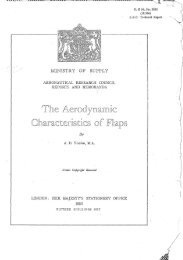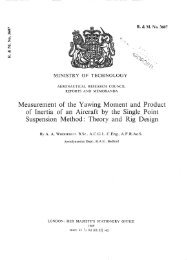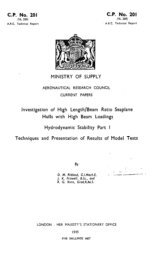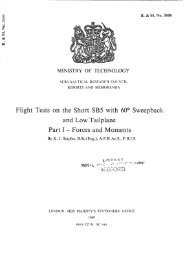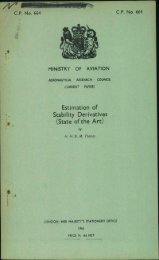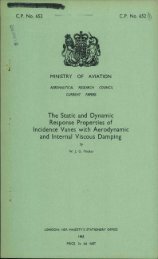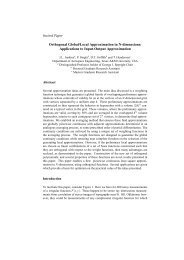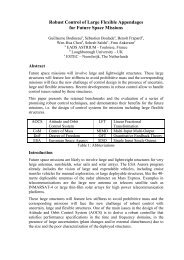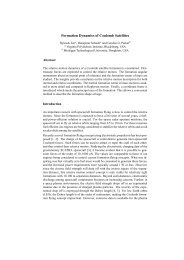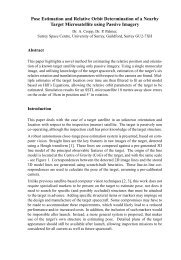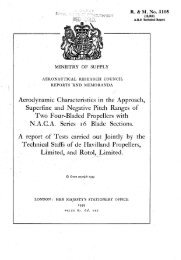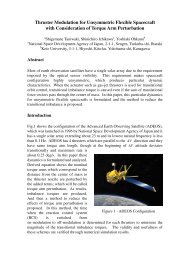A Survey of Unsteady Hypersonic Flow Problems
A Survey of Unsteady Hypersonic Flow Problems
A Survey of Unsteady Hypersonic Flow Problems
Create successful ePaper yourself
Turn your PDF publications into a flip-book with our unique Google optimized e-Paper software.
- 61 -<br />
Most <strong>of</strong> the informatIon relates to the pitching and plunging flutter<br />
<strong>of</strong> a twc-dimensional section, or the similar problem <strong>of</strong> the bending-torsion<br />
flutter <strong>of</strong> a cantilever wing. There is still a need, in this field, to<br />
investigate the use <strong>of</strong> theories applicable to Mach numbers higher than the<br />
piston theory range, and to find an adequate method for estimating the<br />
aerodynamic forces on a sectlon with a blunt leading edge; experimentally,<br />
there is a need for studies that explicitly take account <strong>of</strong> possible non-linear<br />
behaviour, and for further studies on the effects <strong>of</strong> incidence. But this kind<br />
<strong>of</strong> flutter is likely to be <strong>of</strong> comparatively minor importance for hypersonic<br />
vehicles, and there is a great need for more analytical and experimental work<br />
on the flutter <strong>of</strong> low aspect ratio wings and slender bodies, on panel flutter,<br />
and on membrane behaviour.<br />
Work on slender bodies and low aspect ratio wings is likely to be<br />
analytically complex. For pointed slender bodies and wings with supersonic<br />
leading edges, shock expansion theory should give suitable estimates <strong>of</strong> the<br />
aerodynamic forces but Its use in flutter analyses may be ocmplicated. For<br />
blunted nose bodies an adequate aerodynamic analysis does not exist (Appendix I<br />
Experimental work on these bodies and wings could include tests on rigd bodies<br />
flexibly mounted to give a simple check on theories, but would need to be<br />
extended to the use <strong>of</strong> flexible mcdels.<br />
In the case <strong>of</strong> panel flutter, a theoretical investigation <strong>of</strong> the use<br />
<strong>of</strong> piston theory in a steady flow field with large entropy gradients would be<br />
useful since these are the conditions which usually apply downstream <strong>of</strong> the<br />
strong nose shock on a hypersonic vehicle, and experiments would need to be<br />
carefully planned to show what fluid dynamic effects, if any, require special<br />
investigation.<br />
All the experimental results which have been reviewed show clearly<br />
the need in fiture experimental flutter studies for very careful control <strong>of</strong> the<br />
experimental conditions if reliable and precise information is to be obtained<br />
on the merits <strong>of</strong> aerodynamic theories used in flutter analyses.<br />
Finally, the point should be made that the values <strong>of</strong> aerodynamic<br />
damping coefflclents at hypersonic speeds tend to be low, flutter frequency<br />
parameters tend to be small, and the density ratios at which flight takes place<br />
are high. In these conditions the importance <strong>of</strong> aerodynamic damping in flutter<br />
analyses may become negligible (Ref. 62, Section 6-6) and it would then be<br />
possible to use quasi-static air forces and the calculation <strong>of</strong> these forces<br />
would be correspondingly slmpllfled. Clearly, this is a matter which should be<br />
investigated.<br />
Nomenclature/<br />
I).



